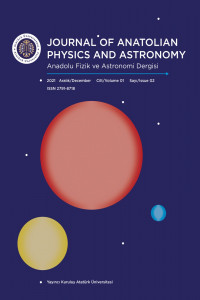BORİK ASİT VE PROPOLİS ENJEKTE EDİLEN YETİŞKİN SPRAGUE DAWLEY SIÇAN KARACİĞERLERİNİN WDXRF SPEKTROMETRESİ İLE ELEMENTAL ANALİZİ
WDXRF, Sprague Dawley Sıçan, Borik Asit, Propolis, Karaciğer
ELEMENTAL ANALYSIS OF BORIC ACID AND PROPOLIS INJECTED ADULT SPRAGUE DAWLEY RAT LIVERS BY WDXRF SPECTROMETER
WDXRF, Sprague Dawley Rat, Boric Acid, Propolis, Liver,
___
- [1] Çelikezen, F. Ç., Toğar, B., Özgeriş, F. B., İzgi, M. S., Türkez, H.Cytogenetic and oxidative alterations after exposure of cultured human whole blood cells to lithium metaborate dehydrate. Cytotechnology, 68(4), 2016, 821-827.
- [2] Devirian, T. A., & Volpe, S. L., The physiological effects of dietary boron. Critical Reviews in Food Science and Nutrition, 43, 2, . 2003, 219-231.
- [3] Türkez, H., Geyikoǧlu, F., Tatar, A., Keleş, S., Özkan, A. Effects of some boron compounds on peripheral human blood. Zeitschrift für Naturforschung C, 62 (11-12), 2007,889-896.
- [4] Nielsen, F.H. Is boron nutritionally relevant?. Nutrition reviews, 66(4), 2008, 183-191.
- [5] Singh D, Chopra K. The effect of naringin, a bioflavonoid on ischemia-reperfusion induced renal injury in rats. Pharmacol Res 50, 2004, 187–193.
- [6] Turkez, H., and Geyikoglu, F. Boric acid: a potential chemoprotective agent against aflatoxin b 1 toxicity in human blood. Cytotechnology, 62(2),2010,157-165.
- [7] Carvalho, M. L., Magalhães, T., Becker, M., & Von Bohlen, A. Trace elements in human cancerous and healthy tissues: A comparative study by EDXRF, TXRF, synchrotron radiation and PIXE. Spectrochimica Acta Part B: Atomic Spectroscopy, 62(9), 2007, 1004-1011.
- [8] Shaltout, A. A., Welz, B., Ibrahim, M. A. Influence of the grain size on the quality of standardless WDXRF analysis of river Nile sediments. Microchemical journal, 99(2), 2011, 356-363.
- [9] Niknami, K. A., Amirkhiz, A. C., & Glascock, M. D. Provenance studies of Chalcolithic obsidian artefacts from near Lake Urmia, northwestern Iran using WDXRF analysis. Archaeometry, 52(1),2010,19-30.
- [10] Özdemir, Y., Börekci, B., Levet, A., & Kurudirek, M. Assessment of trace element concentration distribution in human placenta by wavelength dispersive X-ray fluorescence: effect of neonate weight and maternal age. Applied Radiation and Isotopes, 67(10), 2010, 1790-1795.
- [11] Silva, M.P., Soave, D.F., Ribeiro-Silva, A. et al. Trace elements as tumor biomarkers and prognostic factors in breast cancer: a study through energy dispersive x-ray fluorescence. BMC Res Notes 5, 2012, 194.
- [12] Türkez, H., Yousef, M. I., and Geyikoglu, F. Propolis prevents aluminium-induced genetic and hepatic damages in rat liver. Food and Chemical Toxicology, 48 (10),2010,2741-2746.
- [13] Tohamy, A. A., Abdella, E. M., Ahmed, R. R., and Ahmed, Y. K. Assessment of Anti-Mutagenic, Anti-Histopathologic and Antioxidant Capacities of Egyptian Bee Pollen and Propolis Extracts. Cytotechnology, 66 (2), 2014, 283-297.
- [14] Yılmaz, S., Ustundag, A., Ulker, O. C., and Duydu, Y., Protective effect of boric acid onoxidative DNA damage in Chinese hamster lung fibroblast V79 cell lines. Cell Journal (Yakhteh), 17 (4),2016, 748.
- Başlangıç: 2021
- Yayıncı: Atatürk Üniversitesi
ATA50 TELESKOBU İLE GÖK CİSİMLERİNİN IŞIK ÖLÇÜM GÖZLEMLERİ
Cihan Tuğrul TEZCAN, Fatma TEZCAN, Recep BALBAY, Cahit YEŞİLYAPRAK
BRIDGMAN/STOCKBARGER TEKNİĞİYLE BÜYÜTÜLEN XIIIn2Se4 ÜÇLÜ YARIİLETKENLERİN YAPISAL KARAKTERİZASYONU
Bekir GÜRBULAK, Kübra ALEMDAR DUMAN, Mehmet Kürşat DUMANLI
BİYOLOJİK HEDEFLER İÇİN Dmax DEĞERLERİNİN DURDURMA GÜCÜNE BAĞIMLILIĞI
Zeynep YÜKSEL, M. Çağatay TUFAN
Esra KAVAZ, Fatime GEYİKOĞLU, Neslihan EKİNCİ
ÇEVRESEL ŞARTLARIN TAKİBİNİ YAPAN ÖLÇER SİSTEMİ GELİŞTİRİLMESİ
Recep BALBAY, Cihan Tuğrul TEZCAN, Onur ŞATIR, Cahit YEŞİLYAPRAK
